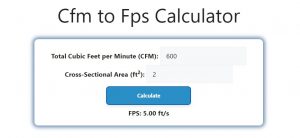About Cfm to Fps Calculator (Formula)
The CFM to FPS Calculator is a valuable tool for anyone working with airflow, particularly in HVAC (Heating, Ventilation, and Air Conditioning) systems, fluid dynamics, and other engineering applications. CFM, or Cubic Feet per Minute, is a measure of the volume of air flow, while FPS, or Feet per Second, indicates the speed of that airflow. Understanding how to convert CFM to FPS is essential for determining the velocity of air in various systems, helping engineers and technicians optimize performance and efficiency.
Formula
The formula for converting CFM to FPS is:
FPS = CFM / (A * 60)
Where:
- FPS = Feet per second (air velocity)
- CFM = Cubic Feet per Minute (airflow)
- A = Cross-sectional area (in square feet)
How to Use
Using the CFM to FPS Calculator is straightforward and involves the following steps:
- Measure Airflow in CFM: Determine the airflow rate in Cubic Feet per Minute (CFM).
- Calculate Cross-Sectional Area (A): Measure or calculate the cross-sectional area of the duct or opening through which the air is flowing, expressed in square feet (ft²).
- Input Values: Enter the CFM value and the cross-sectional area (A) into the calculator.
- Calculate FPS: The calculator will apply the formula to compute the airflow velocity in Feet per Second (FPS).
Example
Let’s consider a practical example:
- Input Values:
- Airflow (CFM) = 600 CFM
- Cross-sectional area (A) = 2 ft²
- Apply the Formula:
- FPS = CFM / (A * 60)
- FPS = 600 / (2 * 60)
- FPS = 600 / 120
- FPS = 5
This means that with an airflow of 600 CFM through a cross-sectional area of 2 ft², the air velocity is 5 feet per second.

FAQs
- What is CFM?
CFM stands for Cubic Feet per Minute, a measure of airflow volume. - What is FPS?
FPS stands for Feet per Second, which measures the speed of airflow. - Why do I need to convert CFM to FPS?
Converting CFM to FPS helps understand how quickly air is moving, which is crucial for system design and efficiency. - How do I measure the cross-sectional area?
The cross-sectional area can be calculated by measuring the width and height of a duct or opening and multiplying these dimensions. - Can this formula be used for any type of airflow?
Yes, this formula can be applied to any airflow, provided the cross-sectional area is accurately measured. - What if I have a non-rectangular duct?
For non-rectangular ducts, use the appropriate geometric formula to calculate the area. - What units are used for airflow and velocity?
Airflow is measured in cubic feet per minute (CFM), and velocity is measured in feet per second (FPS). - Is the conversion affected by temperature or pressure?
The conversion itself is not affected by temperature or pressure, but airflow measurements can be influenced by these factors. - Can I use this calculator for liquids?
This calculator is specifically designed for air or gas flow; different methods may be needed for liquids. - What is the significance of airflow velocity in HVAC systems?
Understanding airflow velocity is vital for maintaining comfort, optimizing energy use, and ensuring adequate ventilation. - How does airflow velocity impact heating or cooling?
Higher airflow velocities can enhance heat transfer, improving heating and cooling efficiency in HVAC systems. - What happens if the cross-sectional area is too small?
If the cross-sectional area is too small for the airflow rate, it can lead to increased pressure drop and potential system failure. - Can I use this calculator for ductwork design?
Yes, it is an essential tool for calculating necessary duct sizes to achieve desired airflow velocities. - How can I increase airflow velocity?
Increasing the airflow rate (CFM) or reducing the cross-sectional area will increase the airflow velocity (FPS). - What factors should I consider for accurate measurements?
Ensure that measurements are taken accurately and consistently, considering any bends or restrictions in the airflow path. - Is this calculation applicable for both residential and commercial systems?
Yes, the CFM to FPS conversion is relevant in both residential and commercial HVAC systems. - How do I ensure optimal airflow in a system?
Regularly maintain and clean ducts, use appropriate duct sizes, and design systems to minimize restrictions. - Can I calculate FPS for multiple ducts at once?
Yes, you can calculate FPS for each duct separately and then sum the results if they share the same airflow source. - What if I have multiple airflow measurements?
You can perform separate calculations for each measurement and then average the results if needed. - Is there a software tool that can assist with these calculations?
Yes, many HVAC design software tools include built-in calculators for airflow conversions.
Conclusion
The CFM to FPS Calculator is an essential resource for engineers, HVAC professionals, and anyone involved in fluid dynamics. By using the formula FPS = CFM / (A * 60), users can easily convert airflow measurements into velocity, allowing for better system design, efficiency optimization, and effective airflow management. Understanding the relationship between CFM and FPS can significantly enhance the performance of various systems, ensuring they operate smoothly and effectively.